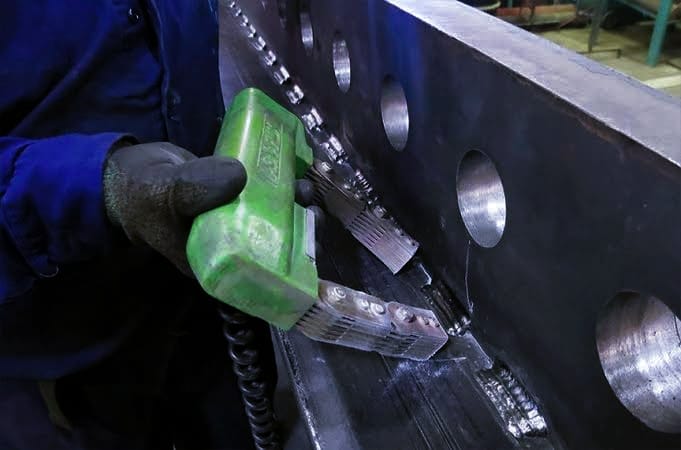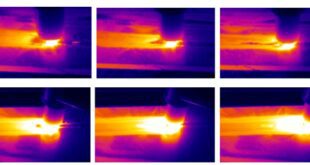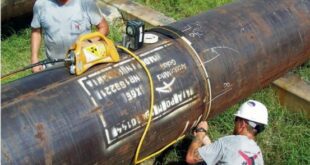Magnetic Particle Inspection – NDT Inspection
Introduction
Magnetic Particle Inspection (MPI) is a non-destructive testing (NDT) technique used to detect surface and subsurface defects in ferromagnetic materials. This method utilizes the magnetic properties of materials to identify defects that are not visible to the naked eye. MPI is commonly used in the manufacturing, construction, and maintenance of critical components such as aircraft parts, pipelines, and bridges.
Definition of Magnetic Particle Inspection
MPI is a technique that uses magnetic fields and magnetic particles to identify surface and subsurface defects in ferromagnetic materials. The inspection process involves the application of a magnetic field to the test piece, followed by the introduction of ferromagnetic particles to the surface of the material. These particles are attracted to areas of magnetic flux leakage caused by defects in the material, thereby creating a visible indication of the defect.
Brief history of Magnetic Particle Inspection
MPI has its roots in the late 19th century, when scientists first discovered the properties of magnetism and its effects on ferromagnetic materials. The earliest known application of magnetic particles to detect defects was in the railroad industry in the early 1900s. However, it wasn’t until the mid-20th century that MPI became widely used in industry.
During World War II, MPI was used extensively to detect defects in aircraft components. This led to the development of more sophisticated MPI equipment and techniques, which eventually led to the widespread adoption of the technique in the aerospace industry. Today, MPI is used in a wide range of industries, including automotive, oil and gas, and construction.
Importance of Magnetic Particle Inspection in different industries
MPI is an essential tool for ensuring the safety and reliability of critical components in a variety of industries. In the aerospace industry, MPI is used to detect defects in aircraft parts such as landing gear, turbine blades, and engine components. In the automotive industry, MPI is used to inspect engine blocks, crankshafts, and other high-stress components. In the oil and gas industry, MPI is used to inspect pipelines, pressure vessels, and storage tanks for defects that could lead to leaks or failures. In the construction industry, MPI is used to inspect welds in steel structures such as bridges and buildings.
The importance of MPI lies in its ability to detect defects that could compromise the structural integrity of critical components. These defects, if left undetected, could result in catastrophic failures that could lead to loss of life, property damage, and environmental disasters. By detecting defects early on, MPI helps to prevent these types of incidents and ensures the safe and reliable operation of critical infrastructure.

Principles of Magnetic Particle Inspection
MPI is based on the principles of magnetism and the behavior of ferromagnetic materials in a magnetic field. Understanding these principles is crucial for performing effective MPI inspections.
Magnetic fields and magnetic flux
Magnetic fields are created by the movement of electric charges. In ferromagnetic materials, the movement of electrons creates a magnetic field that is aligned with the direction of the applied magnetic field. When a magnetic field is applied to a ferromagnetic material, the magnetic flux is concentrated at the ends of the material, creating a north and south pole.
During MPI, magnetic fields are used to detect defects in the material. The magnetic field is applied to the material, and any defects in the material disrupt the flow of magnetic flux. This causes the magnetic particles to accumulate at the site of the defect, creating a visible indication.
Magnetic particle properties
Magnetic particles are small, finely divided particles that are made up of ferromagnetic materials such as iron oxide or iron powder. These particles are introduced to the surface of the material being inspected and are attracted to areas of magnetic flux leakage caused by defects in the material.
The magnetic particles used in MPI are selected based on their magnetic properties, particle size, and surface characteristics. The particles must have a high magnetic susceptibility and must be small enough to flow easily over the surface of the material. The surface of the particles must also be coated with a material that provides good adhesion to the surface of the material being inspected.
Indications and defects
During MPI, defects in the material create a disruption in the flow of magnetic flux. This disruption causes the magnetic particles to accumulate at the site of the defect, creating a visible indication.
MPI can detect a wide range of defects, including cracks, porosity, inclusions, and laps. These defects can be surface-breaking or subsurface, and MPI can be used to detect both types of defects. The type and size of the defect can be determined by the shape and size of the indication created by the magnetic particles.
MPI can also be used to determine the orientation of defects in the material. This information can be used to determine the severity of the defect and to make decisions about whether the component can be repaired or must be replaced.
Magnetic Particle Inspection Techniques
There are two primary techniques used in MPI: dry magnetic particle inspection and wet magnetic particle inspection. Each technique has its own advantages and disadvantages, and the selection of the appropriate technique depends on the specific application.
Dry Magnetic Particle Inspection
- Equipment and materials: Dry MPI uses magnetic particles that are dry and do not require a liquid carrier. The equipment required for dry MPI includes a magnetic yoke or an electromagnetic yoke, magnetic particle applicators, and a black light. The magnetic yoke or electromagnetic yoke is used to apply the magnetic field to the material being inspected, and the magnetic particle applicator is used to apply the dry magnetic particles to the surface of the material.
- Procedure: During dry MPI, the magnetic field is applied to the material being inspected, and the dry magnetic particles are then applied to the surface of the material using a magnetic particle applicator. The particles are attracted to any areas of magnetic flux leakage caused by defects in the material, creating a visible indication. Once the magnetic particles have been applied, the area is examined under a black light to make the indications visible. The indications are then evaluated based on their size, shape, and location to determine the type and severity of the defect.
- Advantages and disadvantages The advantages of dry MPI include the ease of application, the speed of the inspection, and the ability to use the technique in areas where liquid carriers are not allowed or are impractical. However, dry MPI is less sensitive than wet MPI and may miss small or subsurface defects.
Wet Magnetic Particle Inspection
Equipment and materials: Wet MPI uses magnetic particles that are suspended in a liquid carrier. The equipment required for wet MPI includes a magnetic yoke or an electromagnetic yoke, a bath or spray system for applying the particles, and a black light. The liquid carrier can be water-based or oil-based, and the magnetic particles are suspended in the carrier using a wetting agent.
Procedure: During wet MPI, the magnetic field is applied to the material being inspected, and the wet magnetic particles are then applied to the surface of the material using a bath or spray system. The particles are attracted to any areas of magnetic flux leakage caused by defects in the material, creating a visible indication.
Once the magnetic particles have been applied, the area is examined under a black light to make the indications visible. The indications are then evaluated based on their size, shape, and location to determine the type and severity of the defect.
Advantages and disadvantages: The advantages of wet MPI include the ability to detect smaller and deeper defects, the ability to use the technique on irregularly shaped components, and the ability to use different colors of magnetic particles to enhance visibility. However, wet MPI is more complex and time-consuming than dry MPI and requires additional equipment and materials for the liquid carrier. It can also be limited by the environment in which it is used, as water-based carriers cannot be used in certain environments.
Applications of Magnetic Particle Inspection
Magnetic particle inspection is used in various industries where the detection of surface and near-surface defects in ferromagnetic materials is critical. Here are some of the most common industries where MPI is applied:
Aerospace industry
MPI is widely used in the aerospace industry to inspect critical components such as turbine blades, landing gears, and other components that require high reliability and safety. The technique is particularly useful for detecting fatigue cracks, corrosion, and other types of surface defects that may compromise the structural integrity of the components.
Automotive industry
MPI is also used in the automotive industry to inspect engine components, drive shafts, and other critical parts that are subject to stress and fatigue. The technique is particularly useful for detecting cracks and other defects that may not be visible to the naked eye. MPI is also used in the inspection of welded joints in vehicles.
Oil and gas industry
MPI is used in the oil and gas industry to inspect pipelines, tanks, and other equipment that are subject to corrosion, erosion, and other types of wear and tear. The technique is particularly useful for detecting surface and near-surface defects that may cause leaks and other safety hazards. MPI is also used to inspect welds in pipelines and other equipment.
Construction industry
MPI is used in the construction industry to inspect steel structures, bridges, and other critical components that are subject to stress and fatigue. The technique is particularly useful for detecting cracks and other types of surface defects that may compromise the structural integrity of the components. MPI is also used to inspect welds in steel structures.
Limitations of Magnetic Particle Inspection
While magnetic particle inspection (MPI) is a highly effective non-destructive testing technique, it does have some limitations that should be taken into consideration. Here are some of the most common limitations of MPI:
Surface inspection limitations
MPI is primarily a surface inspection technique, which means it can only detect defects that are on or near the surface of the material being inspected. This means that defects that are located deeper within the material may not be detected by MPI. In order to detect subsurface defects, other non-destructive testing techniques such as radiography or ultrasonic testing may be needed.
Subsurface inspection limitations
While MPI is capable of detecting some subsurface defects, its ability to do so is limited. The technique can only detect subsurface defects that are close to the surface and that cause a disruption in the magnetic field. Deeper subsurface defects may not be detected by MPI.
Magnetic particle limitations
MPI is limited by the properties of the magnetic particles used in the inspection process. The size, shape, and composition of the particles can affect their ability to detect defects. Additionally, the magnetic field strength and direction can also impact the detection of defects. This means that the inspector needs to carefully select the right magnetic particles and magnetic field settings to ensure accurate defect detection.
Advancements in Magnetic Particle Inspection
Magnetic particle inspection (MPI) has been around for several decades and has evolved significantly over time. Here are some of the latest advancements in MPI:
New technologies and methods
Several new technologies and methods have been developed in recent years to enhance the effectiveness and efficiency of MPI. One such technology is the use of digital MPI, which involves the use of digital sensors and software to analyze the magnetic field and detect defects. Another technology is the use of alternating current field measurement (ACFM) for surface crack detection, which offers higher sensitivity and accuracy than traditional MPI methods.
Improvements in equipment and materials
Improvements have been made in the equipment and materials used in MPI to enhance its effectiveness and ease of use. For example, new magnetizing equipment has been developed that offers greater control and precision over the magnetic field, allowing for more accurate defect detection. In addition, new magnetic particles have been developed that are more sensitive and can detect smaller defects.
Future developments
The future of MPI is likely to involve further advancements in technology, equipment, and materials. For example, researchers are exploring the use of artificial intelligence and machine learning algorithms to analyze the data collected during MPI inspections and detect defects automatically. Additionally, efforts are being made to develop MPI techniques that can detect defects in non-ferromagnetic materials, such as aluminum and titanium alloys.
FAQs
Why is magnetic particle inspection important?
Magnetic particle inspection is important because it is a non-destructive testing technique that can detect surface and subsurface defects in ferromagnetic materials. It is widely used in various industries to ensure the safety and reliability of critical components and structures, such as aircraft parts, pipelines, and bridges..
What are the most important step in magnetic particle inspection?
The most important steps in magnetic particle inspection include preparing the surface of the material being inspected, applying the magnetic field, applying the magnetic particles, and interpreting the results. Proper preparation of the surface is critical to ensure accurate detection of defects.
What is one advantage of magnetic particle inspection?
One advantage of magnetic particle inspection is that it is a non-destructive testing technique that can detect surface and subsurface defects in ferromagnetic materials without damaging the material. It is also a relatively simple and cost-effective technique compared to other non-destructive testing methods.
What is the objective of magnetic particle testing?
The objective of magnetic particle testing is to detect surface and subsurface defects in ferromagnetic materials using a non-destructive testing technique. This can help ensure the safety and reliability of critical components and structures in various industries.
What is the safety of magnetic particle testing?
Magnetic particle testing is generally considered a safe non-destructive testing technique when performed by trained and qualified personnel. However, safety precautions must be taken, such as using proper protective equipment, to prevent accidents and ensure the safety of inspectors and others in the vicinity.
Where is magnetic particle testing used?
Magnetic particle testing is used in various industries, including aerospace, automotive, oil and gas, and construction. It is particularly useful for detecting defects in ferromagnetic materials, such as steel and iron.
What is magnetic particle inspection also known as?
Magnetic particle inspection is also known as magnetic particle testing or magnetic particle examination.
How does magnetic particle inspection work?
Magnetic particle inspection works by applying a magnetic field to the material being inspected and then applying magnetic particles that are attracted to areas of flux leakage caused by defects. The particles make the defects visible to the inspector, allowing for accurate detection and evaluation of defects.
Conclusion
Magnetic particle inspection (MPI) is a highly effective non-destructive testing technique that has been used for many decades to detect surface and subsurface defects in ferromagnetic materials. The technique involves the application of a magnetic field to the material being inspected, followed by the application of magnetic particles that are attracted to areas of flux leakage caused by defects.
MPI has a wide range of applications in various industries, including aerospace, automotive, oil and gas, and construction. It is an important tool in ensuring the safety and reliability of critical components and structures, such as aircraft parts, pipelines, and bridges.
While MPI has some limitations, such as its surface inspection capabilities and magnetic particle limitations, the technique has seen significant advancements in recent years. New technologies, methods, and materials have been developed to enhance the effectiveness and efficiency of MPI, and the future of the technique is likely to involve further advancements, such as the use of artificial intelligence and machine learning algorithms.
 Welding of Welders All about Welding and Welders
Welding of Welders All about Welding and Welders



